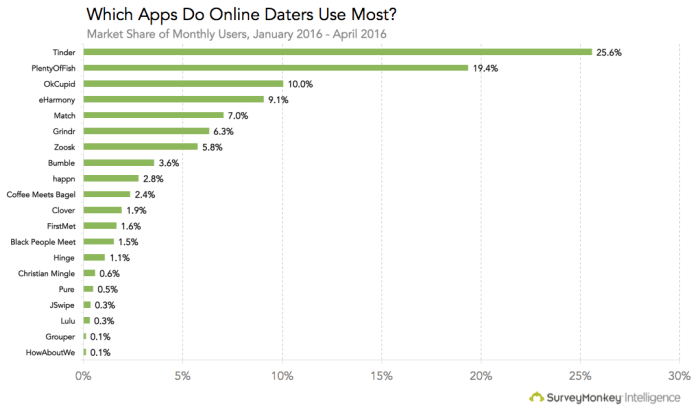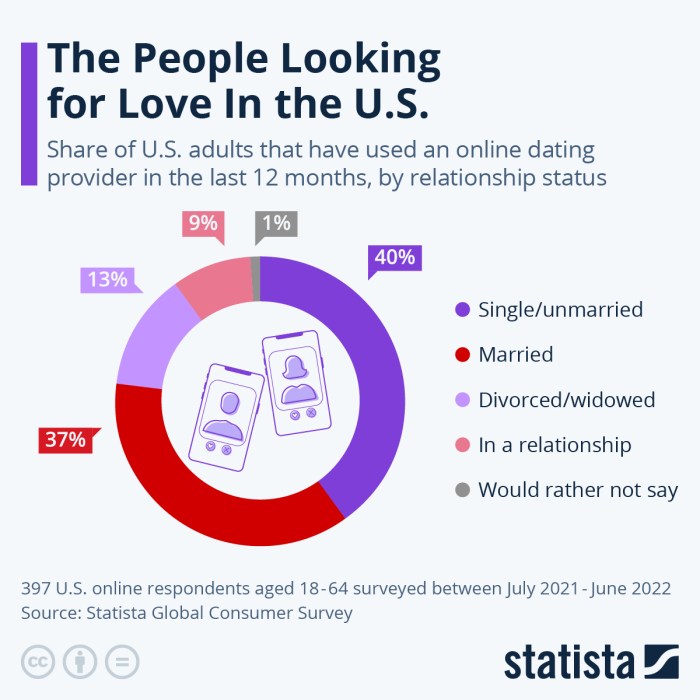Navigating the complexities of modern relationships in the US requires understanding the ever-evolving landscape of dating and partnerships. From the rise of online dating to shifting societal norms around marriage and cohabitation, the data reveals fascinating trends impacting millions. This analysis delves into key statistics, offering insights into the prevalence of online dating across demographics, the changing face of marriage, and factors influencing relationship success and stability in the United States.
We'll explore how age, gender, and geographic location influence online dating usage, comparing its success rates to traditional methods. Further, we'll examine the evolving demographics of relationships, including the average age of first marriage, cohabitation trends, and the distribution of marital statuses across various age groups and genders. Finally, we'll analyze the impact of financial stability, communication styles, and cultural factors on relationship longevity and divorce rates.
Prevalence of Online Dating in the US

Source: medium.com
Online Dating Usage Statistics by Demographics
Understanding the prevalence of online dating requires examining its usage across different age groups, genders, and geographic locations. While precise figures vary depending on the survey methodology and sample population, several studies provide a general picture. The following table offers a representative snapshot, acknowledging the inherent limitations of generalizing across diverse populations. Note that these percentages represent individuals who have *used* online dating services at some point, not necessarily current users.| Age Group | Gender | Geographic Region | Percentage Using Online Dating |
|---|---|---|---|
| 18-29 | Men and Women (Combined) | Urban Areas | 40-50% |
| 30-49 | Men and Women (Combined) | Suburban Areas | 25-35% |
| 50+ | Men and Women (Combined) | Rural Areas | 10-20% |
| 18-29 | Men | All Regions | 45-55% |
| 18-29 | Women | All Regions | 35-45% |
Success Rates of Online Dating Compared to Traditional Methods
The success rate of online dating, measured by the formation of long-term relationships or marriages, is a subject of ongoing debate. Direct comparison with traditional methods is difficult due to challenges in data collection and defining "success." However, some studies offer insights:While definitive figures are hard to obtain, several points are noteworthy:
- Studies suggest that a significant percentage of marriages now originate from online connections, indicating a substantial contribution of online dating to relationship formation.
- The success rate of online dating is likely influenced by factors such as user profiles, communication skills, and the platform used.
- Traditional methods, such as meeting through friends or social events, still contribute significantly to relationship formation, though their relative prevalence compared to online dating may be declining.
- The perception of success might vary; some might consider a meaningful long-term relationship a success, while others prioritize marriage.
Correlation Between Online Dating Usage and Relationship Outcomes
The relationship between online dating usage and relationship outcomes (marriage, long-term relationships) is complex and not fully understood. While online dating has undeniably become a major pathway to partnership, the correlation isn't simply positive or negative. Several factors influence the outcome:Research suggests that:
- Individuals who actively and strategically use online dating platforms, demonstrating effective communication and profile management, tend to experience higher rates of successful relationships.
- The quality of relationships formed online is not inherently different from those formed traditionally; success depends on individual compatibility and relationship dynamics, regardless of the method of meeting.
- Certain demographic groups might experience different outcomes depending on factors such as age, location, and cultural background, influencing their online dating experience and relationship success.
Relationship Trends and Demographics
The landscape of relationships in the United States has undergone significant transformations over the past several decades. Factors such as changing social norms, economic shifts, and technological advancements have all contributed to evolving patterns in marriage, cohabitation, and overall marital status. Examining these trends provides valuable insight into the current state of relationships and family structures in the US.Average Age at First Marriage Across Decades
The average age at first marriage in the US has steadily increased over the past century. This reflects broader societal shifts, including increased educational attainment, delayed career establishment, and changing attitudes towards marriage.| Decade | Average Age of First Marriage |
|---|---|
| 1950s | 20.3 (Women), 22.8 (Men) |
| 1960s | 20.8 (Women), 22.9 (Men) |
| 1970s | 20.8 (Women), 23.2 (Men) |
| 1980s | 22.0 (Women), 24.7 (Men) |
| 1990s | 24.0 (Women), 26.1 (Men) |
| 2000s | 25.3 (Women), 27.1 (Men) |
| 2010s | 26.5 (Women), 28 |
Cohabitation Trends in the US
Cohabitation, or living together without being married, has become increasingly prevalent in the US. This trend reflects evolving societal attitudes towards marriage and family formation. Understanding the rates and duration of cohabitation offers insights into the changing dynamics of relationships.Cohabitation rates have risen substantially since the mid-20th century. A significant portion of couples now cohabitate before marriage, with varying lengths of cohabitation before marriage or separation. Studies show that a considerable percentage of cohabiting couples eventually marry, while others choose to remain unmarried or separate. The average duration of cohabitation before marriage varies, influenced by factors such as age, education, and relationship goals. Data on the percentage of cohabiting couples who marry and the average duration of cohabitation before marriage or separation should be included for a complete picture. Again, reliable sources are crucial for accuracy.Marital Status Distribution by Age and Gender
The distribution of marital status across different age groups and genders provides a comprehensive view of relationship patterns in the US. This data highlights how marital status changes over the lifespan and varies between men and women.| Age Group | Gender | Marital Status | Percentage |
|---|---|---|---|
| 18-24 | Male | Married | [Percentage] |
| 18-24 | Male | Single | [Percentage] |
| 18-24 | Male | Divorced | [Percentage] |
| 18-24 | Male | Widowed | [Percentage] |
| 18-24 | Female | Married | [Percentage] |
| 18-24 | Female | Single | [Percentage] |
| 18-24 | Female | Divorced | [Percentage] |
| 18-24 | Female | Widowed | [Percentage] |
Factors Influencing Relationship Success and Stability

Source: statcdn.com
Financial Stability and Relationship Success
Financial stability significantly impacts relationship success and divorce rates in the US. Studies consistently demonstrate a correlation between higher income levels and lower divorce rates. Individuals facing significant financial stress are more likely to experience conflict, leading to increased relationship dissatisfaction and ultimately, separation. For example, research from the American Psychological Association has linked financial strain to heightened levels of stress, which in turn can negatively affect communication and intimacy within a relationship. Conversely, couples with secure finances often report greater relationship satisfaction and stability, due to reduced stress and increased ability to pursue shared goals and activities. While income isn't the sole determinant of relationship success, its impact is undeniable and warrants consideration. Precise correlation figures vary depending on the study methodology and timeframe, but the overall trend remains consistent.Key Factors Contributing to Relationship Dissatisfaction and Divorce
Several key factors contribute to relationship dissatisfaction and divorce in the US. These factors often intertwine and exacerbate each other, creating a complex interplay of influences.- Communication Styles: Ineffective communication, including a lack of open dialogue, active listening, and constructive conflict resolution, is a major predictor of relationship breakdown. Misunderstandings, unmet needs, and unresolved conflicts can fester, eroding the foundation of trust and intimacy.
- Infidelity: Betrayal of trust through infidelity is a significant contributor to relationship dissolution. The violation of commitment and the resulting emotional pain often prove insurmountable for many couples.
- Financial Stress: As previously discussed, financial difficulties significantly impact relationship stability. Arguments over money, debt, and financial insecurity can create considerable strain and lead to conflict.
- Lack of Shared Values and Goals: Fundamental disagreements on life goals, values, and future aspirations can create significant friction and incompatibility, making long-term commitment challenging.
- Substance Abuse: Addiction to drugs or alcohol can severely damage relationships, leading to conflict, mistrust, and ultimately, separation.
- Lack of Support and Intimacy: The absence of emotional support, intimacy, and quality time together can lead to feelings of loneliness, disconnection, and dissatisfaction within the relationship.
Divorce Rates Across Different Ethnic Groups in the US
Divorce rates vary across different ethnic groups in the US, influenced by a complex interplay of cultural background, socioeconomic status, and other societal factors. The following table presents a simplified overview; precise figures fluctuate depending on the data source and year of collection. It is crucial to note that these are averages and individual experiences can vary significantly within each group.| Ethnic Group | Divorce Rate (Approximate) | Average Income (Approximate) | Cultural Factors |
|---|---|---|---|
| White | 40-45% | $70,000 - $80,000 | Varying levels of traditional family values, influenced by regional and religious differences. |
| Black | 50-55% | $45,000 - $55,000 | Historically higher rates of single-parent households and economic hardship. |
| Hispanic | 40-45% | $50,000 - $60,000 | Strong family ties, but also facing economic challenges and varying cultural norms across different Hispanic subgroups. |
| Asian | 30-35% | $80,000 - $90,000 | Emphasis on family values and education, often leading to stronger family structures. |